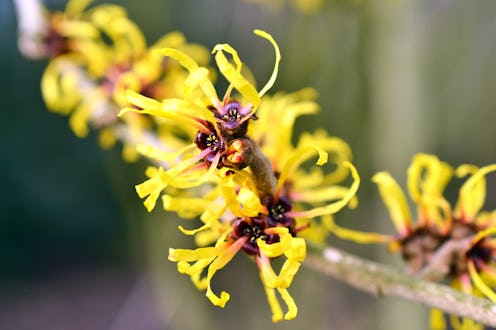Life
6 Surprising Uses For Witch Hazel

You may have heard about witch hazel as a cheap and easy solution for many skin issues. But if you have never used the natural astringent before, you may not know how to utilize it. There are a number of surprising uses for witch hazel, including treating acne, and reducing redness and inflammation. If you're not putting to use this versatile ingredient, you may be missing out.
Although the name may make it seem like it was concocted in a cauldron, witch hazel is actually naturally derived from a shrub known as Hamamelis virginiana. The leaf, bark, and twigs are used to make medicine, according to WebMD. Witch hazel contains chemicals called tannins, which when applied directly to the skin, can help reduce swelling, repair broken skin, and fight bacteria.
"The tannins in witch have shown in scientific studies to have antimicrobial, antiviral, anti-inflammatory and antioxidant properties," dermatologist Dr. Richard Torbeck with Advanced Dermatology PC, tells Bustle. "The trend in medicine is to provide products that are closer to nature. You would be hard pressed to find a more natural product than witch hazel. There are other products created from witch hazel such as, witch hazel water, gels, and lotions, but the main active ingredient for the resultant effect are the tannins."
If you want to put this natural ingredient to use, consider these six surprising ways you can use witch hazel, according to experts.
1Relieving Itching
Witch hazel can be used to help relieve itching and discomfort. "Witch hazel can be used to help itching due to insect bites and may ease mild discomfort from bruising," dermatologist Dr. David Lortscher, CEO of Curology, tells Bustle. You can even use witch hazel on your hair, as it can reduce scalp itching and redness, dermatologist Dr. Ava Shamban, founder of SkinFive, tells Bustle. She suggests applying before you do your shampoo.
2Reducing Swelling
"The tannins and volatile oils in witch hazel make it an all- natural astringent, shrinking swollen tissues," Dr. Lortscher says. Some uses include treating hemorrhoids, varicose veins, nose bleeds, etc., according to dermatologist Dr. Daniel Siegel, board member at Kamedis Dermatology.
3Reducing Redness & Inflammation
If you have red and inflamed skin, witch hazel may be able to come to the rescue. "The antioxidants in witch hazel help neutralize free radicals, repairing skin damage and reducing inflammation," Dr. Lortscher says. "The gallic acid and tannins in witch hazel might help reduce inflammation in skin conditions like acne, sunburn and eczema."
4Treating Warts
Because the tannins in witch hazel have antiviral properties, they can be applied topically to help fight against warts from the Human Papilloma Virus (HPV). "In regards to the antimicrobial/viral realm, there is data that shows that witch hazel can be used to treat HPV, a common cause of warts, particularly HPV16 that causes genital warts," Dr. Torbeck says. While you should still talk to your doctor if you believe you may have HPV, witch hazel could be something to ask them about.
5Helping To Heal Cuts
Witch hazel is most commonly used as an astringent, but this means it can also be used in a first-aid situation. "Astringents are any compounds that tighten the skin by chemical means," Dr. Torbeck says. "Witch hazel’s astringent ability has made it useful for minor bleeding events like cuts or reducing the appearance of bruises."
6Helping With Acne
Again, because of its astringent and anti-viral effects, witch hazel is a great ingredient to use to fight acne. "It is able to reduce active acne lesions, and the anti-inflammatory properties reduce the red discoloration from an acne bump," Dr. Torbeck says. Witch hazel can be very drying and can irritate the skin, so be careful not to use too much when treating pimples.
Witch hazel can be a great natural remedy, but if you plan to use witch hazel instead of more tried and true methods, make sure to seek out a doctor’s advice.